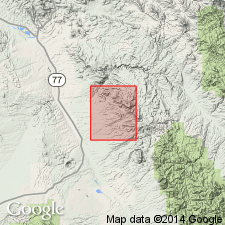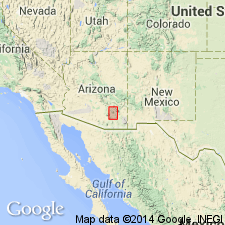
- Usage in publication:
-
- Holy Joe Member*
- Modifications:
-
- Named
- Reference
- Dominant lithology:
-
- Tuff
- AAPG geologic province:
-
- Basin-and-Range province
Summary:
Named as one of ten map units in the Galiuro Volcanics for exposures (its type locality) on Holy Joe Peak, sec 7, T7S, R18E, Pinal Co, AZ in the Basin-and-Range province. Reference sections designated on north side of Table Mountain in sec 8, T7S, R18E, and in Oak Springs Canyon, secs 5 and 6, T7S, R18E. Formerly called lower welded tuff unit. Consists of quartz-latite ash-flow tuff. Is a single cooling unit of several ash flows. Has abundant crystal fragments (quartz, plagioclase, biotite, sanidine), pumice shards, lapilli. Is 149+ ft thick in Oak Springs Canyon measured section. Forms dark cliffs with prominent planes representing individual flows and/or zones of intense welding. Mapped in northeast part and in a small area along Zapata Wash in west part of quad. Overlies andesite of Little Table Mountain, and underlies tuff of Oak Springs Canyon, both units of Galiuro. Assigned a Miocene age. Has K-Ar age of 22.4 to 25.9 m.y.
Source: GNU records (USGS DDS-6; Denver GNULEX).

- Usage in publication:
-
- Holy Joe Member*
- Modifications:
-
- Geochronologic dating
- Age modified
- AAPG geologic province:
-
- Basin-and-Range province
Summary:
As a member of the Galiuro Volcanics, has isotopic ages of 26.5 +/-0.8 m.y. and 26.7 +/-0.8 m.y. on biotite, and 25.6 +/-0.8 m.y. on sanidine, or late Oligocene. Age changed from Miocene to Oligocene. Occurs in the northern Galiuro Mountains, AZ, Basin-and-Range province. Geologic map; correlation chart.
Source: GNU records (USGS DDS-6; Denver GNULEX).

- Usage in publication:
-
- Holy Joe Member*
- Modifications:
-
- Age modified
- AAPG geologic province:
-
- Basin-and-Range province
Summary:
Age of the Holy Joe Member of the Galiuro Volcanics is late Oligocene based on isotopic (K-Ar) ages of 26.5 +/-0.8 Ma (biotite) and 25.6 +/-0.8 Ma (sanidine).
Source: GNU records (USGS DDS-6; Menlo GNULEX).
For more information, please contact Nancy Stamm, Geologic Names Committee Secretary.
Asterisk (*) indicates published by U.S. Geological Survey authors.
"No current usage" (†) implies that a name has been abandoned or has fallen into disuse. Former usage and, if known, replacement name given in parentheses ( ).
Slash (/) indicates name conflicts with nomenclatural guidelines (CSN, 1933; ACSN, 1961, 1970; NACSN, 1983, 2005, 2021). May be explained within brackets ([ ]).

